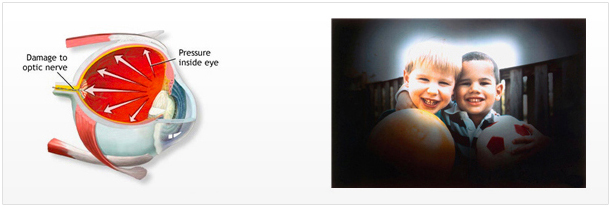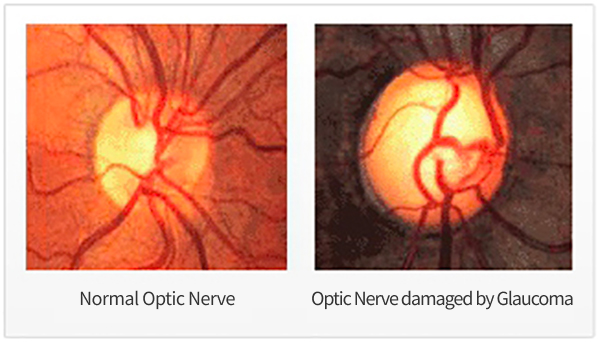“First-class Medical Staff & comprehensive System”
Siloam Eye Hospital will Safeguard your Health.

What is Glaucoma?
Glaucoma is a condition in which the optic nerve cells die, resulting in visual impairment.

Various factors can cause the intraocular pressure to rise, which leads to optic nerve cells dying due to the pressure; and this in turn can lead to visual impairment in the affected area of the patient’s eye—is what we call glaucoma. Since glaucoma has no clear symptoms and the field of vision narrows only gradually, it is often diagnosed late and discovered after the glaucoma has already progressed considerably. Since these sensitive optic nerves cannot be restored once damaged, early diagnosis and treatment is the most effective method of combatting this eye disease.
In most cases, the symptoms of glaucoma do not manifest until advanced stages of vision loss. When patients realize that their eyesight has deteriorated, is already too late or extremely difficult to treat effectively. Therefore, getting a regular glaucoma examination at least once a year, regardless of discomfort in the eye is really the only failsafe method to successfully prevent blindness due to glaucoma.
Symptoms of Glaucoma
- Failing Eyesight
- Blurred Vision
- Rings appear around Lights
- Red Eye, Eyes feel Heavy or Tire easily
- Severe Headaches
- Nausea & Vomiting
- Stiff Shoulders
- Difficulty descending stairs.
Treatment of Glaucoma

The treatment of glaucoma is to control the intraocular pressure in the eye by inhibiting the production of aqueous humor—transparent water-like fluid secreted from the ciliary body in the eye chamber—or by promoting faster drainage of aqueous humor through the aqueous outflow channel.
- Pharmacotherapy: This form of treatment primarily uses eye drops or oral medications to lower intraocular pressure.
- Laser therapy: Laser is used to perform an iridotomy & trabeculoplasty to promote better outflow of aqueous humor.
- Surgical Therapy: If intraocular pressure cannot be controlled with drugs or lasers, the surgical procedure called a trabeculectomy is performed.
Ocular Hypertension
Although the optic nerve and field of vision may be normal, when the intraocular pressure exceeds 21mmHg to a level higher than the normal range, and there are no systemic abnormalities causing this increase in intraocular pressure—we refer to this as ocular hypertension. Because these patients with ocular hypertension are at much higher risk for glaucoma, it is sometimes called ‘early glaucoma without glaucoma or visual field damage’. It is important to keep in mind that patients with ocular hypertension have a high likelihood of developing primary open-angle glaucoma.
If a patient’s intraocular pressure exceeds 30mmHg, it is strongly recommended to start treatment, and for those whose below 30mmHg, visual field and optic nerve changes should be monitored regularly even if the decision for treatment is not made. However, in cases where patients have high-risk factors that may cause glaucoma—such as optic nerve damage, retinal changes, old age, family history of glaucoma, systemic cardiovascular disease—it is strongly recommended to start treatment immediately.
Primary Open-Angle Glaucoma
Primary open-angle glaucoma is a severe form of glaucoma that requires continuous screening and treatment without fail.
Open-angle glaucoma is the most representative type of glaucoma, when the intraocular pressure rises above 21 mmHg and characteristics of glaucoma, like optic nerve damage and changes in the visual field, appear.
In open-angle glaucoma, the pressure in the eye gradually and gradually increases over several years or decades, so patients rarely come to the hospital complaining of symptoms. In addition, since the visual acuity is almost normal even at the later stages when the optic nerve is significantly damaged, by the time the patient acutely notices visually impairment and visits the hospital—the glaucoma has already progressed to advanced stages. Therefore, early detection of glaucoma is of utmost importance in preventing blindness due to glaucoma.
Treatment of Primary Open-Angle Glaucoma
The primary goal of all glaucoma treatment is to prevent severe vision loss or blindness. As increased intraocular pressure is what causes damage to the optic nerves, treatment involves implementing measures to lower this intraocular pressure. Chronic open-angle glaucoma can usually be treated with drugs, however, if medication alone does not sufficiently lower the intraocular pressure, then laser treatment or surgery options are available. The patient’s condition determines which of these two methods is preferable. The good news is that patients can live a normal life without any further visual impairment, if the intraocular pressure is properly controlled or treated early. Therefore, even when patients believe their glaucoma has been cured when their intraocular pressure returns to normal after treatment or surgery, it is essential to continue having regular check-ups and treatment to vigilantly monitor one’s condition.




